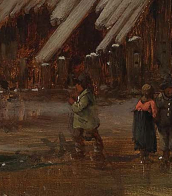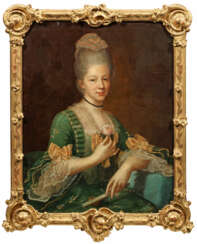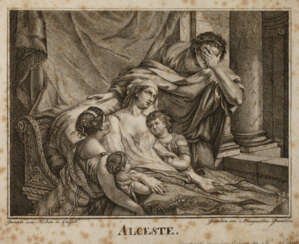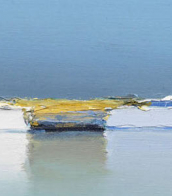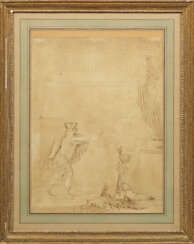august tischbein

Johann Friedrich August Tischbein was a German painter of the last quarter of the 18th and early 19th centuries. He is known as an academic painter of the Classical era, specializing in portraits, a representative of a large dynasty of artists.
August Tischbein was court painter to Prince Friedrich Karl August and Prince Leopold III Friedrich Franz. He traveled to Italy, where he improved his skills in portrait painting, and achieved success in Berlin and Dresden. In 1799, the artist became director of the Academy of Fine Arts in Leipzig. From 1806 to 1808 he worked in St. Petersburg, where he created portraits of courtiers and representatives of the aristocracy. His works are characterized by strict composition, exquisite coloring and sentimental style of the era. Several of his paintings can be found in the St. Petersburg Hermitage.


Johann Friedrich August Tischbein was a German painter of the last quarter of the 18th and early 19th centuries. He is known as an academic painter of the Classical era, specializing in portraits, a representative of a large dynasty of artists.
August Tischbein was court painter to Prince Friedrich Karl August and Prince Leopold III Friedrich Franz. He traveled to Italy, where he improved his skills in portrait painting, and achieved success in Berlin and Dresden. In 1799, the artist became director of the Academy of Fine Arts in Leipzig. From 1806 to 1808 he worked in St. Petersburg, where he created portraits of courtiers and representatives of the aristocracy. His works are characterized by strict composition, exquisite coloring and sentimental style of the era. Several of his paintings can be found in the St. Petersburg Hermitage.


Johann Friedrich August Tischbein was a German painter of the last quarter of the 18th and early 19th centuries. He is known as an academic painter of the Classical era, specializing in portraits, a representative of a large dynasty of artists.
August Tischbein was court painter to Prince Friedrich Karl August and Prince Leopold III Friedrich Franz. He traveled to Italy, where he improved his skills in portrait painting, and achieved success in Berlin and Dresden. In 1799, the artist became director of the Academy of Fine Arts in Leipzig. From 1806 to 1808 he worked in St. Petersburg, where he created portraits of courtiers and representatives of the aristocracy. His works are characterized by strict composition, exquisite coloring and sentimental style of the era. Several of his paintings can be found in the St. Petersburg Hermitage.


Johann Heinrich Tischbein the Elder, known as the Kasseler Tischbein, was one of the most respected European painters in the 18th century and an important member of the Tischbein family of German painters, which spanned three generations.
His work consisted primarily of portraits of the nobility, mythological scenes, and historical paintings. For his mythology paintings his models were mostly members of the upper nobility.


Johann Heinrich Tischbein the Elder, known as the Kasseler Tischbein, was one of the most respected European painters in the 18th century and an important member of the Tischbein family of German painters, which spanned three generations.
His work consisted primarily of portraits of the nobility, mythological scenes, and historical paintings. For his mythology paintings his models were mostly members of the upper nobility.


Johann Heinrich Tischbein the Elder, known as the Kasseler Tischbein, was one of the most respected European painters in the 18th century and an important member of the Tischbein family of German painters, which spanned three generations.
His work consisted primarily of portraits of the nobility, mythological scenes, and historical paintings. For his mythology paintings his models were mostly members of the upper nobility.


Johann Heinrich Tischbein the Elder, known as the Kasseler Tischbein, was one of the most respected European painters in the 18th century and an important member of the Tischbein family of German painters, which spanned three generations.
His work consisted primarily of portraits of the nobility, mythological scenes, and historical paintings. For his mythology paintings his models were mostly members of the upper nobility.


Johann Friedrich August Tischbein was a German painter of the last quarter of the 18th and early 19th centuries. He is known as an academic painter of the Classical era, specializing in portraits, a representative of a large dynasty of artists.
August Tischbein was court painter to Prince Friedrich Karl August and Prince Leopold III Friedrich Franz. He traveled to Italy, where he improved his skills in portrait painting, and achieved success in Berlin and Dresden. In 1799, the artist became director of the Academy of Fine Arts in Leipzig. From 1806 to 1808 he worked in St. Petersburg, where he created portraits of courtiers and representatives of the aristocracy. His works are characterized by strict composition, exquisite coloring and sentimental style of the era. Several of his paintings can be found in the St. Petersburg Hermitage.


Johann Friedrich August Tischbein was a German painter of the last quarter of the 18th and early 19th centuries. He is known as an academic painter of the Classical era, specializing in portraits, a representative of a large dynasty of artists.
August Tischbein was court painter to Prince Friedrich Karl August and Prince Leopold III Friedrich Franz. He traveled to Italy, where he improved his skills in portrait painting, and achieved success in Berlin and Dresden. In 1799, the artist became director of the Academy of Fine Arts in Leipzig. From 1806 to 1808 he worked in St. Petersburg, where he created portraits of courtiers and representatives of the aristocracy. His works are characterized by strict composition, exquisite coloring and sentimental style of the era. Several of his paintings can be found in the St. Petersburg Hermitage.


Johann Joseph Zoffany, born Johannes Josephus Zaufallij, was a German neoclassical painter who was active mainly in England, Italy and India. His works appear in many prominent British collections, including the National Gallery, the Tate Gallery and the Royal Collection, as well as institutions in continental Europe, India, the United States and Australia.


















